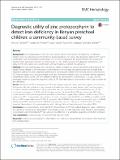| dc.contributor.author | Emily M. Teshome, Andrew M. Prentice, Ayşe Y. Demir, Pauline E.A. Andang’o & Hans Verhoef | |
| dc.date.accessioned | 2022-01-29T09:38:45Z | |
| dc.date.available | 2022-01-29T09:38:45Z | |
| dc.date.issued | 2017 | |
| dc.identifier.uri | https://repository.maseno.ac.ke/handle/123456789/4753 | |
| dc.description | DOI 10.1186/s12878-017-0082-z | en_US |
| dc.description.abstract | Zinc protoporphyrin (ZPP) has been used to screen and manage iron deficiency in individual
children, but it has also been recommended to assess population iron status. The diagnostic utility of ZPP used in
combination with haemoglobin concentration has not been evaluated in pre-school children. We aimed to a)
identify factors associated with ZPP in children aged 12–36 months; b) assess the diagnostic performance and
utility of ZPP, either alone or in combination with haemoglobin, to detect iron deficiency. | en_US |
| dc.publisher | BMC Hematology | en_US |
| dc.subject | : Erythrocyte protoporphyrin, Inflammation, Iron deficiency, Kenya, Malaria, Plasmodium, Child, Preschool, Zinc protoporphyrin | en_US |
| dc.title | Diagnostic utility of zinc protoporphyrin to detect iron deficiency in Kenyan preschool children: a community-based survey | en_US |
| dc.type | Article | en_US |

